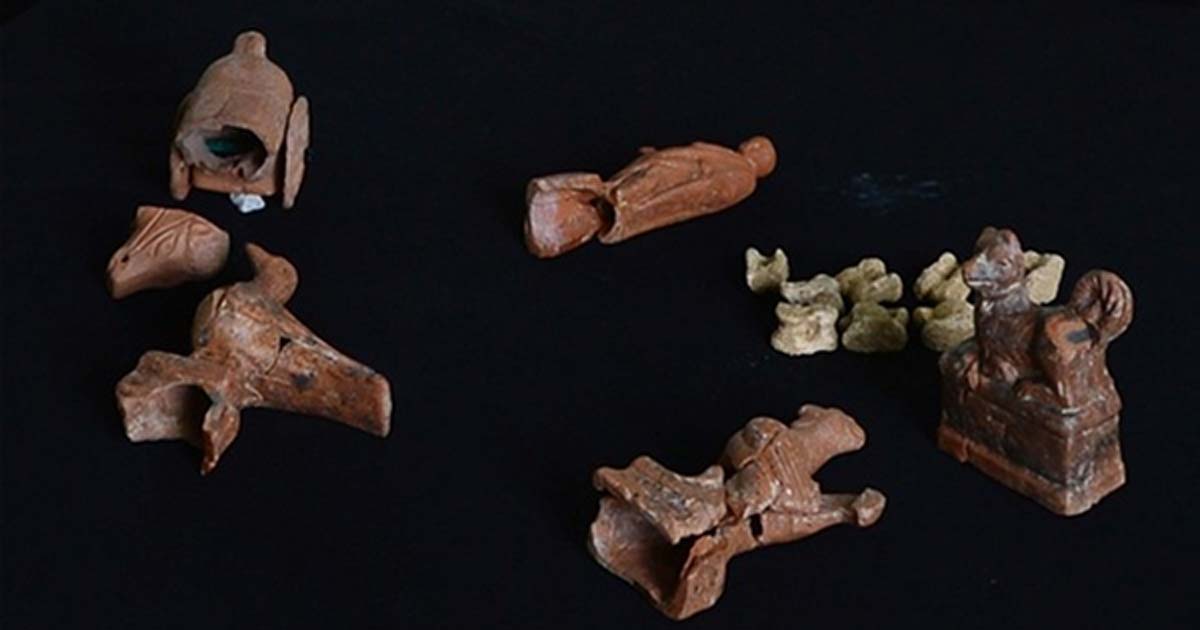Touching Discovery of 2,000-Year-Old Toys Inside Ancient Greek Child Tombs
Archaeologists made a moving discovery inside the 2,000-year-old tombs of children in the ancient Greek seaport city of Parion, now in modern-day Turkey. Excavations of several ancient graves revealed a number of children’s toys, which are believed to have been offered as gifts for the dead children to accompany them on their journey to the afterlife.
According to The Daily Sabah, Professor Hasan Kasaoğlu from Atatürk University and director of the excavation works at Parion, located in Turkey’s Çanakkale province, stated that female figurines were discovered in tombs belonging to girls, while male figurines were unearthed in boys’ tombs. Kasaoğlu said that the new findings could provide valuable information about the sociocultural structure of the period. "2,000 years ago girls played with 'Barbie-like' dolls, the same way they do now," Kasaoğlu told The Daily Sabah, adding that despite toys changing drastically throughout the centuries, the need of humans to play and be entertained has remained the same to this day.
The Importance of Toys Throughout the Centuries
Toys have always been an important part of daily life in human settlements and various archaeological finds have proved that repeatedly. As previously reported in a 2015 Ancient Origins article, tiny figurines were discovered in the grave of an infant which, according to archeologists, dates back 4,500 years. One of the theories proposed that the figurines may have been used as rattling toys or charms to ward off evil spirits. The discovery was made on the northwest shore of Lake Itkul in the Minusinsk basin of Russia by researchers of the Russian Academy of Sciences and the Khakassian Research Institute of Language, Literature and History.
The remains of the infant were found in a birchbark cradle, a fact that indicated that the child was less than one-year-old at the time of death. On the infant’s chest, archaeologists discovered eight miniature horned figurines representing human-like characters and heads of elk, boar, birds and an unknown carnivore. The figurines were carved from deer antlers and painted with red ochre. Some of them, according to the researchers, had internal cavities and could produce sounds like modern rattles.

Infant discovered in 4,500-year-old burial mound with eight intricately carved figurines. Credit: Image courtesy Yury Esin.
Furthermore, in 2016 Natalia Klimczak reported for Ancient Origins, the discovery of an early Bronze Age toy equivalent to the modern rattle at the Acemhöyük excavation site in Yeşilova, Aksaray. The unique artifact shed some light on children and daily life in ancient times.
The toy was sealed but had tiny ornaments and small pebble stones inside, while archaeologists were surprised to find that it can still produce a noise when the rattle is shaken. The toy is shaped like a ball and it used to have a handle which may have helped the child or an adult to shake it. It is made of terra-cotta and was discovered in a layer dated back to 2200 BC.

The Bronze Age rattle discovered at the Acemhöyük excavation site in Turkey. Source: GTU Gazeturka.com
Figurines Depicting Animals and Mythological Figures Also Unearthed
Fast forward to 2017, Dr. Kasaoğlu noted that the human figurines weren’t the only ones the archaeologists discovered at the site. Figurines depicting animals and Greek mythological creatures were also discovered in the tombs. Interestingly, earlier in September, excavators also discovered a baby bottle at the site.
Founded in 709 BC, the ancient city of Parion (also known as Parium) was a Greek colony that belonged to the Delian League. During the Hellenistic period it came under the domain of Lysimachus, and subsequently the Attalid dynasty. In Roman times, it was a Roman settlement, within the province of Asia. After that province was divided in the 4th century, it was in the province of Hellespontus. The ancient coinage of Parium is quite abundant, attesting to its great output and advanced mint (in Hellenistic times, the city's badge shown on coins was the Gorgoneion). Archaeologists have been carrying out excavations at the ancient site since 2005, unearthing several sarcophagi and graves, as well as ancient artifacts in the area.
Top image: Toys discovered inside the ancient child tombs.




















Comments
to say the story was 'touching' is kind of funny as they not only touched the kids stuff, i am fairly certain they took the toys home for further study...all of archaeology seems like entertainment at best and quite disturbing to say the least. i keep reading and looking for the good in archaeology but i find it funny rather than 'touching' that people spend their lives digging old stuff up from the ground. i keep having visions of beagles sniffing around trying to remember where they buried that long lost bone.